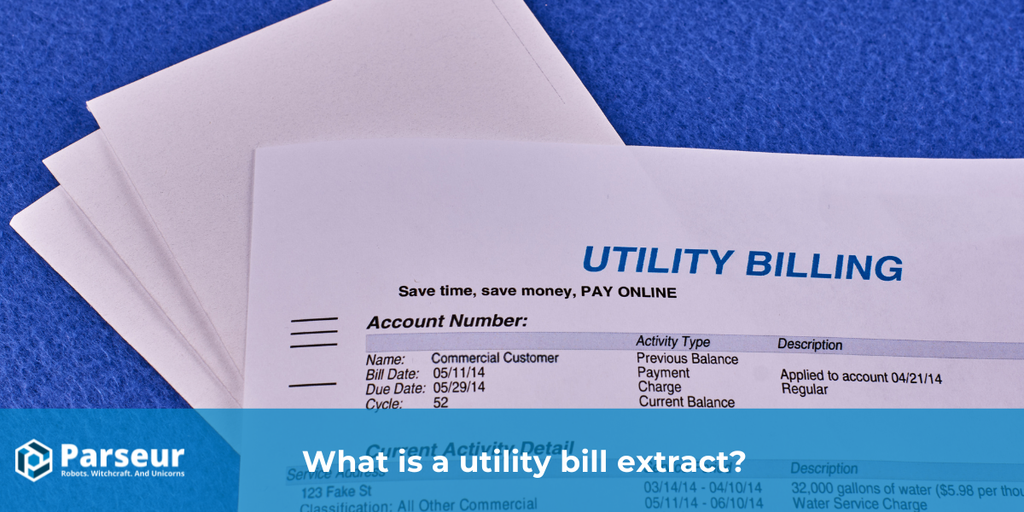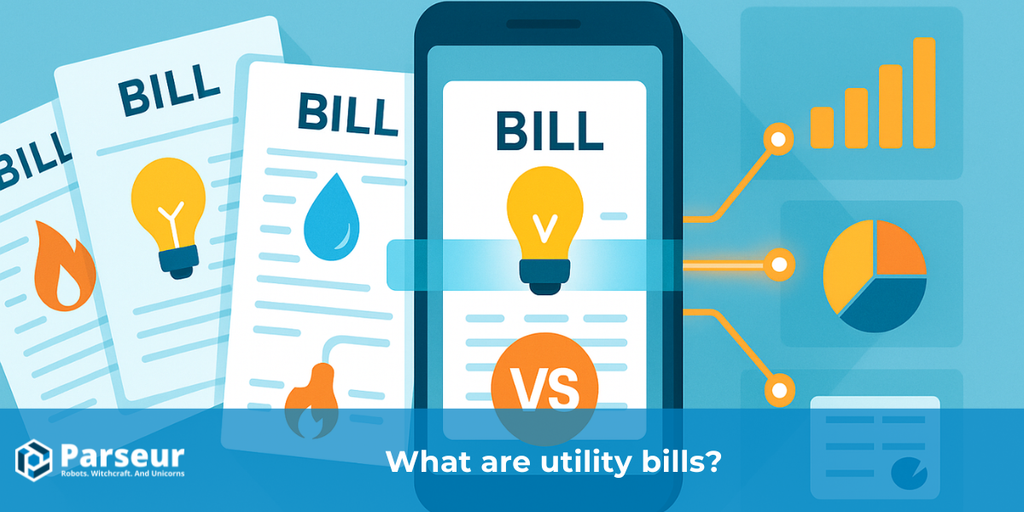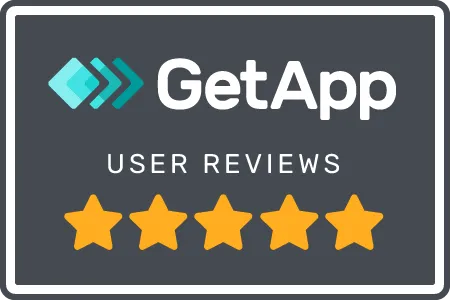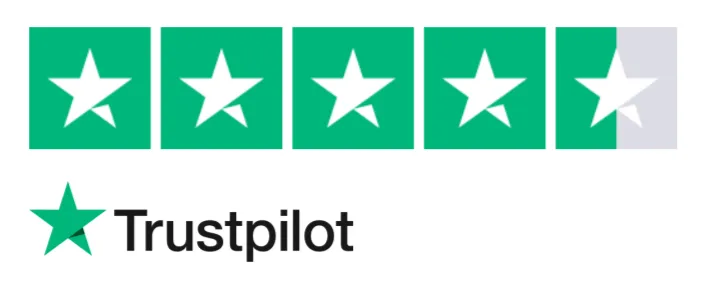What are the challenges of utility bill extraction?
The challenges of utility bill extraction include handling low-quality documents, scalability, compliance, and integration with existing systems.
Key Takeaways
- Automating utility bill extraction reduces errors and saves time compared to manual data entry.
- AI-powered OCR handles diverse bill formats and improves accuracy, even with low-quality scans.
- Secure, scalable, and integrated solutions ensure compliance and maximize ROI.
Utility companies, enterprises, and energy management firms process millions of utility bills every month. These bills are essential for tracking energy consumption, managing costs, and ensuring accurate reporting; however, the process is often complex. Many organizations still rely on manual data entry, which is slow, costly, and prone to errors.
According to a detailed 2025 survey conducted by Parseur in partnership with QuestionPro, manual data entry tasks cost American companies an average of $28,500 per employee annually. But these financial costs are only the tip of the iceberg. The same survey found that 56% of employees experience burnout due to repetitive tasks, and research consistently links burnout to decreased productivity, higher turnover, and lower overall morale.
This is why more businesses are turning to automation tools that use OCR (Optical Character Recognition) and AI-powered document processing to extract utility bill data automatically.
However, automation does not always sail smoothly. While the promise of efficiency and accuracy is appealing, companies quickly realize that automating utility bill extraction comes with unique challenges. From highly variable bill formats and poor-quality scans to compliance issues and system integrations, these obstacles can stall even the most promising automation projects.
This article explores the top five challenges in automating utility bill extraction and shows how to overcome them. Backed by real-world data and practical examples, it also highlights how Parseur’s AI-powered document processing platform helps businesses go beyond traditional utility bill OCR by delivering clean and structured data at scale.
This guide will help you understand the roadblocks and proven strategies for automating utility bill parsing efficiently, securely, and at scale.
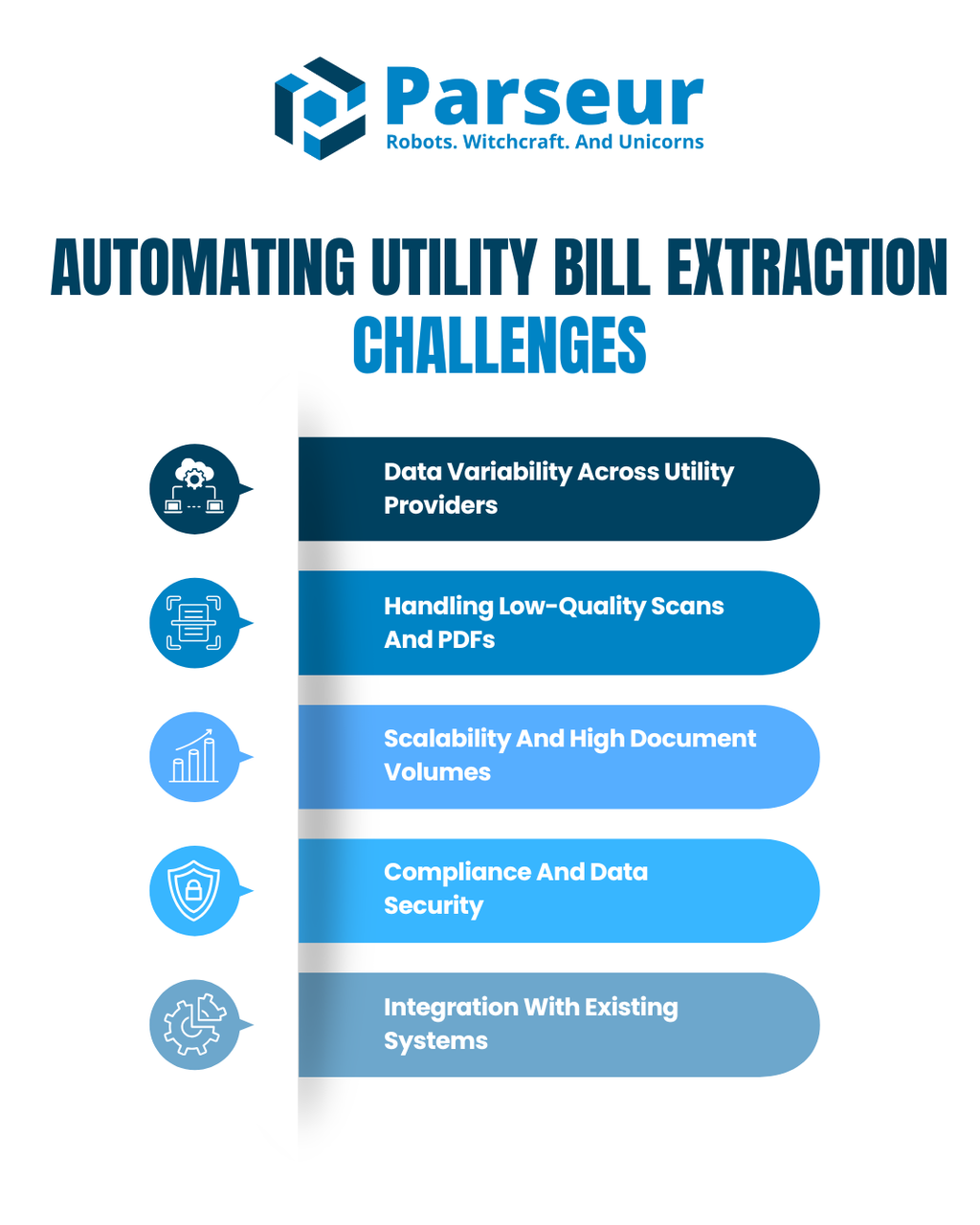
Challenge 1: Data Variability Across Utility Providers
One of the biggest obstacles in automating utility bill extraction is the sheer diversity of formats. Every utility provider has its own way of designing bills, with unique layouts, field placements, and terminology. An electricity bill often includes details such as kilowatt usage and meter readings, while a gas bill highlights consumption in cubic meters. A telecom bill might list account numbers, call charges, and bundled services. Even within the same category, two providers rarely follow the same format.
This variability creates significant problems for traditional OCR tools. Standard OCR can read text, but struggles when the location of fields changes or the document structure is unfamiliar. The result is incomplete or inaccurate data extraction, often forcing teams to intervene manually.
According to Parseur’s 2025 survey, employees already spend more than 9 hours per week on manual data entry tasks, and over 50.4% of respondents report errors or delays as a direct result of these processes. Over time, this defeats the purpose of automation and increases operational costs.
The problem is not unique to utilities. As reported by Forbes, 80–90% of business data is unstructured, like emails, PDFs, and scans, making it difficult to process using traditional automation tools. Utility bills are a clear example of unstructured papers because of their wide range of formats and layouts. This challenge becomes one of the main barriers to achieving efficiency for businesses handling thousands of bills every month across different providers and regions.
Parseur addresses this issue with AI-powered OCR parsing technology. Instead of relying on rigid templates, Parseur uses AI and machine learning to identify and extract fields dynamically. This means that whether the bill comes from an electricity provider, a gas supplier, a telecom company, or a regional water utility, the platform adapts automatically and delivers clean, structured data every time. By eliminating the need to constantly build and maintain templates, Parseur enables companies to scale their utility bill automation with ease and confidence.
Challenge 2: Handling Low-Quality Scans And PDFs
Another major challenge in utility bill automation is the poor quality of scanned documents and PDFs. Many utility providers still deliver bills in formats that are difficult to process, especially when customers scan paper bills or download low-resolution PDFs. These documents often contain blurred text, smudges, watermarks, handwritten notes, or rotated pages, all of which make accurate data extraction difficult.
Traditional OCR systems are particularly vulnerable to this problem. When text is unclear or distorted, the OCR engine may misread characters or fail to capture data entirely. For example, the number “8” might be mistaken for a “0,” or a customer account number could be split into multiple fragments. These minor errors can create significant problems for businesses that depend on precise data for billing, reporting, and compliance.
According to a report by WifiTalents, 25-30% of business processes are affected by poor data quality, costing organizations millions each year. This highlights how critical it is to have technology that can handle imperfect inputs. Utility companies and enterprises cannot always control the quality of the documents they receive, which makes resilience a key factor in choosing the right automation solution.
Parseur tackles this issue with advanced preprocessing and AI-enhanced OCR. The platform automatically cleans and normalizes documents, improves readability, and extracts data even from low-quality scans. It also uses context to validate results, ensuring that numbers and fields make sense within the structure of a utility bill. As a result, businesses can rely on accurate data extraction, regardless of how clean or messy the input file may be.
Challenge 3: Scalability And High Document Volumes
For many enterprises, the real test of utility bill automation comes when processing shifts from a handful of documents to thousands or even millions of bills every month. A small pilot project may perform well, but once volumes increase, the limitations of traditional OCR or rule-based systems become clear. High document volumes put pressure on speed, accuracy, and infrastructure, often forcing teams to spend more time managing exceptions than benefiting from automation.
Manual intervention becomes a serious bottleneck. If even 5 percent of bills require human review, that could mean thousands of documents still being processed manually. Parseur’s 2025 survey also found that 46.2% of employees have never used automation tools for data entry, highlighting a major scalability gap when organizations try to expand beyond small-scale projects.
This drives up costs and reduces the efficiency gains that automation was meant to deliver. In industries like energy management, telecom, and real estate, where utility bills are received from multiple regions and providers, scalability is often the deciding factor in whether automation succeeds.
Scalability is one of the most critical challenges for organizations looking to automate utility bill parsing across large operations. According to McKinsey, 57% of organizations are piloting automation, but many struggle to move beyond pilots into full-scale deployment, highlighting the gap between ambition and execution.
Parseur is designed with scalability in mind. The platform can handle thousands of documents per hour without sacrificing accuracy, and its cloud-based infrastructure ensures that businesses can scale up or down as needed. Features like bulk document processing, intelligent routing, and seamless integrations with ERPs, CRMs, and accounting tools mean teams can process high volumes of utility bills in real time without building additional infrastructure. This enables companies to achieve true end-to-end automation at scale.
Challenge 4: Compliance And Data Security
Utility bills often contain sensitive information such as customer names, addresses, account numbers, and payment histories. For enterprises processing thousands of bills, safeguarding this data is not just best practice but a legal requirement. Regulatory frameworks like GDPR in Europe, CCPA in California, and various energy industry regulations worldwide impose strict standards for handling, storing, and sharing customer data. Non-compliance can lead to significant fines, reputational damage, and loss of customer trust.
Traditional OCR tools may extract text successfully, but rarely come with built-in compliance and security features. Data might be exposed during manual handling, stored in unsecured systems, or shared without proper encryption. These gaps create serious business risks, especially for those managing utility data across multiple jurisdictions.
The importance of compliance cannot be overstated. According to IBM’s annual Cost of a Data Breach report, the global average cost of a data breach reached 4.4 million US dollars; a 9% decrease over last year, driven by faster identification and containment, the highest on record. Even a small oversight can lead to costly consequences for companies processing utility bills at scale.
Parseur addresses this challenge with enterprise-grade security and compliance features. All documents are processed in secure, cloud-based environments with encrypted data transfer and storage. Role-based access controls ensure only authorized team members can view or manage sensitive documents. In addition, Parseur is GDPR-compliant, giving organizations confidence that personal data is handled responsibly and in line with international regulations. By combining accurate extraction with strong compliance measures, Parseur helps businesses protect customer data while achieving automation at scale.
Challenge 5: Integration With Existing Systems
Even when utility bill data is extracted accurately, the next challenge is ensuring that data flows seamlessly into the systems businesses already use. Most organizations rely on a mix of accounting software, ERP platforms, CRMs, and energy management systems to track expenses, budgets, and consumption. If extracted data cannot be transferred automatically into these tools, teams fall back on manual uploads or custom scripts, which reduces efficiency and increases error risks.
Integration is often underestimated but is one of the most critical factors in a successful automation strategy. Without it, automation stops halfway. Teams may save time on extraction, only to lose those gains while reformatting and re-entering data into downstream systems.
According to PwC’s Digital Trends in Operations Survey, 47% of operations and supply chain leaders cite integration complexity as one of the top reasons their tech investments haven’t delivered full value. This shows how important it is for automation tools to work with the platforms businesses already depend on.
Parseur solves this issue with ready-made integrations and flexibility. The platform connects directly with thousands of applications through Zapier, Make, and Power Automate and offers a robust API for custom integrations. This ensures that extracted utility bill data can flow instantly into accounting software, databases, or business dashboards without manual effort. Parseur enables companies to achieve true end-to-end automation by reducing the friction between extraction and utilization.
Automating utility bill extraction is no longer a “nice to have”; it has become a critical requirement for enterprises dealing with thousands of invoices and statements monthly. While the promise of automation is compelling, the journey is rarely straightforward. From managing data variability across different utility providers to handling low-quality scans, ensuring scalability, maintaining compliance, and integrating with existing systems, businesses often face significant obstacles that slow down or even derail their automation projects.
These challenges explain why many organizations still rely on time-consuming manual processes or patchwork solutions that fail to scale. Manual bill review wastes valuable staff hours and increases the risk of errors, leading to missed payments, compliance issues, and inaccurate financial reporting. The result is a system that drains resources instead of delivering the efficiency and insight that modern businesses need.
The good news is that these obstacles can be overcome with the right technology. Parseur is purpose-built to address the toughest challenges in utility bill automation. Its AI-powered OCR and Key Information Extraction capabilities go beyond traditional OCR tools by delivering clean, structured data from any bill format without relying on rigid templates. Combined with enterprise-grade security, GDPR compliance, and cloud scalability, Parseur ensures that businesses can automate confidently while protecting sensitive customer data.
Perhaps most importantly, Parseur closes the gap between data extraction and data utilization. With ready-made integrations to accounting platforms, ERPs, CRMs, and automation tools like Zapier and Make, businesses can directly connect extracted utility bill data into their workflows in real time. This eliminates manual re-entry, reduces operational costs, and frees teams to focus on higher-value tasks.
Efficiency and accuracy are no longer optional; they are essential. By adopting Parseur for utility bill automation, businesses gain more than just speed. They gain a scalable, compliant, and reliable solution that transforms utility bill management from a repetitive back-office task into a streamlined process that drives better financial control and strategic decision-making.
Ready to eliminate manual data entry and automate your utility bill processing? Try Parseur today and experience how AI-powered automation can save time, reduce costs, and improve accuracy for your business.
Frequently Asked Questions
When businesses explore automation, a lot of questions come up about accuracy, scalability, and compliance. To help you understand how automation works in practice, here are some of the most common questions about automating utility bill extraction.
-
What is utility bill extraction automation?
-
Utility bill extraction automation uses AI-powered OCR and data parsing tools to capture key details such as account numbers, billing amounts, usage data, and due dates from utility bills and export them into structured formats like JSON and Excel or directly into accounting systems.
-
How accurate is automated utility bill extraction?
-
Modern tools powered by AI and machine learning achieve accuracy rates of over 95 percent, even when working with varied formats. Solutions like Parseur continuously improve results through template-free parsing, making them more reliable than traditional OCR alone.
-
Can automation handle scanned or low-quality utility bills?
-
Yes. Advanced preprocessing and AI-enhanced OCR can clean and normalize scanned or low-resolution documents before extracting data. This allows automation systems to capture information accurately, even from imperfect PDFs or images.
-
Is automated utility bill extraction secure and compliant?
-
Yes. Leading solutions follow strict compliance standards such as GDPR and CCPA. They use encryption, secure cloud storage, and role-based access to ensure the protection of sensitive customer and financial data.
-
How does utility bill extraction software integrate with existing systems?
-
Automation platforms like Parseur integrate directly with popular ERPs, CRMs, and accounting tools. They also connect to workflow automation platforms such as Zapier, Make, and Power Automate, making it easy to push data into the systems your business already uses.
Last updated on

